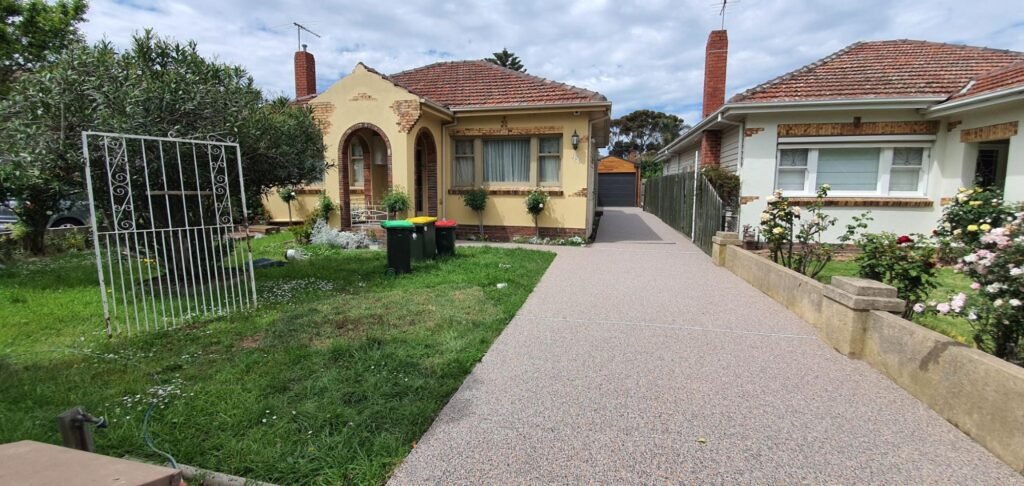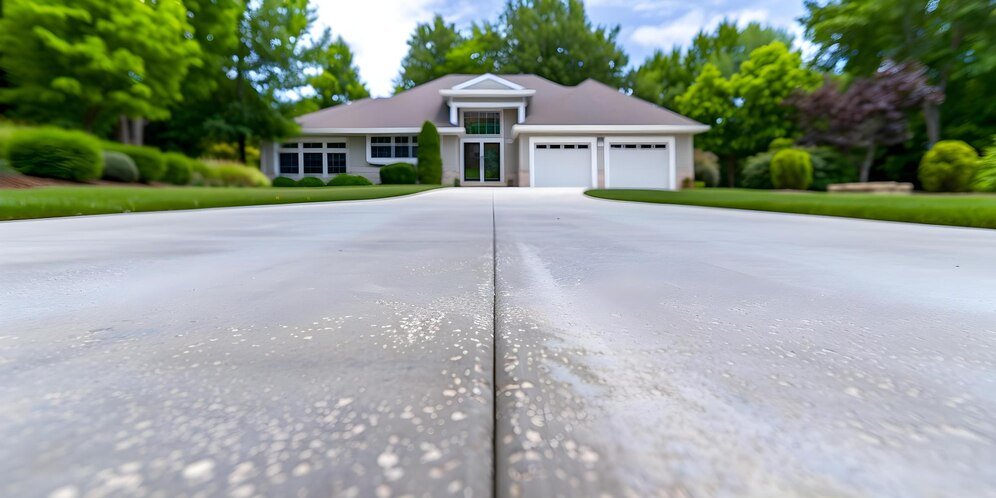Introduction
Did you know that a well-maintained driveway can increase your home’s value by up to 10%?
Driveway resurfacing is a crucial home improvement task that often goes overlooked. It involves applying a new layer of material to the existing surface to restore its look and functionality. This process can significantly enhance the curb appeal and durability of your driveway.
In this article, you will learn what driveway resurfacing is, the benefits it offers, and how to identify when your driveway needs resurfacing. Understanding these aspects will help you make informed decisions about maintaining your driveway and preserving your property’s value.
2. Understanding Driveway Resurfacing
: Driveway resurfacing is the process of applying a new layer of material over an existing driveway surface to repair damage and improve its appearance. This is different from a full replacement, which involves removing and replacing the entire driveway.
Benefits:
- Improved Appearance: A fresh layer of material can make your driveway look new again, enhancing the overall appearance of your property.
- Increased Property Value: A well-maintained driveway can boost your home’s curb appeal, potentially increasing its market value.
- Extended Lifespan: Resurfacing can address minor damages and prevent further deterioration, extending the lifespan of your driveway.
- Cost-Effective: Compared to a full replacement, resurfacing is a more affordable option that still provides significant benefits.
3. Signs Your Driveway Needs Resurfacing
Cracks and Potholes:
- Over time, driveways can develop cracks and potholes due to weather conditions, heavy usage, and ground movement. Small cracks might not seem like a big deal, but they can expand and lead to more serious damage if left unattended.
- Why Resurface? Resurfacing fills in these imperfections, creating a smooth and even surface that is safer and more attractive.
Water Pooling:
- Poor drainage can cause water to pool on the surface of your driveway. This standing water can seep into the cracks and exacerbate damage over time.
- Why Resurface? Resurfacing can help correct drainage issues by creating a more even surface and improving the driveway’s slope.
Aging Surface:
- Driveways naturally wear out over time due to exposure to the elements and regular use. Signs of aging include a faded appearance, rough texture, and small surface cracks.
- Why Resurface? Applying a new layer of material can rejuvenate an old driveway, making it look and function like new without the need for a complete replacement.
By recognizing these signs, you can take timely action to resurface your driveway, preventing further damage and maintaining its functionality and appearance.

4. Types of Driveway Resurfacing
Asphalt Resurfacing:
- Process: Asphalt resurfacing involves cleaning the existing surface, filling in cracks and potholes, and applying a new layer of asphalt over the old one. This new layer is compacted to ensure a smooth and even finish.
- Advantages: Asphalt is durable, cost-effective, and quick to install. It also provides a smooth surface that is easy to maintain.
- Suitability: Ideal for driveways with significant wear but a solid foundation. It’s also suitable for areas with varying temperatures due to its flexibility and ability to expand and contract without cracking.
Concrete Resurfacing:
- Steps: Concrete resurfacing starts with cleaning the driveway and repairing any damage. A bonding agent is applied to the old surface, followed by a new layer of concrete. This layer can be textured or colored for a decorative finish.
- Benefits: Concrete is highly durable and long-lasting. It offers a variety of finishes, including stamped or stained concrete, which can enhance the aesthetic appeal.
- Best Option: Suitable for driveways that have minor surface damage but are structurally sound. Ideal for homeowners looking for a durable and customizable option.
Gravel Resurfacing:
- Process: Gravel resurfacing involves removing the top layer of the old gravel, grading the driveway to ensure proper drainage, and adding a fresh layer of gravel.
- Benefits: Gravel driveways are inexpensive, easy to install, and provide excellent drainage. They are also environmentally friendly as they allow rainwater to infiltrate the ground.
- Best for Certain Environments: Ideal for rural or rustic settings where a more natural look is desired. It’s also a good choice for long driveways where cost is a major consideration.
Other Materials:
- Pavers: Pavers offer a high-end look and come in various shapes, colors, and patterns. They are durable and can be replaced individually if damaged.
- Cobblestones: Cobblestones provide a classic, timeless appearance and are extremely durable. They are suitable for historic homes or those looking for a unique driveway surface.
5. The Resurfacing Process
Assessment:
- Initial Inspection: A thorough inspection of the driveway is conducted to assess its current condition, including the extent of damage, drainage issues, and the overall stability of the foundation.
Preparation:
- Cleaning: The driveway is cleaned to remove dirt, debris, and any loose materials. Pressure washing is often used for this step.
- Filling Cracks: Any cracks or potholes are filled with appropriate materials to ensure a smooth surface for the new layer.
- Leveling: The surface is leveled and graded to ensure proper drainage and even application of the new material.
Resurfacing Application:
- New Surface Material: The chosen resurfacing material (asphalt, concrete, gravel, etc.) is applied over the prepared surface. This step may involve spreading, pouring, or laying the material, depending on the type used.
- Compaction: For materials like asphalt and gravel, compaction is performed to ensure a dense, stable surface.
Curing and Finishing:
- Curing Time: The resurfaced driveway is left to cure, which can vary depending on the material. Asphalt typically takes a few days, while concrete may take a week or more.
- Final Touches: Once cured, any final touches are added, such as sealing the surface, adding decorative elements, or performing a final inspection to ensure quality.
6. Cost Considerations
Factors Affecting Cost:
- Driveway Size: Larger driveways require more materials and labor, increasing the overall cost.
- Material Choice: Different materials have varying costs. Asphalt is generally cheaper than concrete, while pavers and cobblestones are more expensive.
- Labor Costs: Professional installation costs can vary based on the complexity of the job and regional labor rates.
- Condition of Existing Driveway: The extent of repairs needed on the existing driveway can also impact the cost.
Budgeting Tips:
- Get Multiple Quotes: Obtain quotes from several contractors to compare prices and services.
- Plan for Contingencies: Set aside extra funds for unexpected issues that may arise during the project.
- Consider Long-Term Costs: While some materials may have a higher upfront cost, they may offer better durability and lower maintenance costs over time.
- DIY Options: For those with the necessary skills and tools, consider doing some of the preparation work yourself to save on labor costs.

-
DIY vs. Professional Resurfacing
Pros and Cons of DIY:
Pros:
- Cost Savings: One of the primary benefits of DIY resurfacing is the potential to save money on labor costs.
- Control Over the Process: Doing the work yourself allows you to control every aspect of the project, from materials to timing.
- Learning Experience: DIY projects can be rewarding and provide valuable experience in home improvement.
Cons:
- Time-Consuming: Resurfacing a driveway is a labor-intensive process that can take significant time, especially for inexperienced individuals.
- Skill and Knowledge Requirements: Proper resurfacing requires a good understanding of the materials and techniques involved. Mistakes can be costly and difficult to fix.
- Equipment Costs: Specialized equipment may be needed, which can be expensive to rent or purchase.
Hiring Professionals:
Advantages:
- Expertise: Professional contractors have the experience and skills to ensure the job is done correctly and efficiently.
- Quality Materials and Tools: Professionals have access to high-quality materials and the necessary tools, ensuring a durable and aesthetically pleasing result.
- Time Efficiency: Hiring professionals can save you time, allowing you to focus on other tasks or responsibilities.
- Warranty and Insurance: Reputable contractors often provide warranties on their work and are insured, providing peace of mind in case of any issues.
What to Look for When Choosing a Contractor:
- Experience and Reputation: Look for contractors with a proven track record and positive customer reviews.
- Licensing and Insurance: Ensure the contractor is licensed and insured to protect yourself from potential liabilities.
- Detailed Quotes: Obtain detailed quotes that outline the scope of work, materials, costs, and timelines.
- References: Ask for references and contact previous clients to gauge their satisfaction with the contractor’s work.
8. Maintenance Tips for Resurfaced Driveways
Regular Cleaning:
- Advice: Keep the surface clean by regularly sweeping away debris, dirt, and leaves. This prevents staining and reduces the risk of damage from organic materials breaking down on the surface.
- Pressure Washing: Occasionally use a pressure washer to remove deep-seated dirt and grime, but ensure it’s done gently to avoid damaging the surface.
Sealing:
- Information: Sealing your driveway can protect it from water, chemicals, and UV rays. For asphalt, sealcoating is recommended every 2-3 years, while concrete driveways benefit from a penetrating sealer every few years.
- Benefits: Sealing extends the lifespan of the driveway, enhances its appearance, and makes it easier to clean.
Repairing Minor Issues:
-
- Tips: Address small cracks and holes as soon as they appear to prevent them from expanding. Use appropriate fillers or patching compounds for the material of your driveway.
- Regular Inspections: Perform regular inspections to identify and repair minor issues before they become major problems.
9. Conclusion
- Driveway resurfacing in melbourne is a cost-effective way to improve the appearance, value, and longevity of your driveway.
- Understanding the different types of resurfacing materials and processes can help you choose the best option for your needs.
- Recognizing the signs that your driveway needs resurfacing and knowing the steps involved in the process are crucial for maintaining your driveway.
- Whether you choose to tackle the project yourself or hire professionals, it’s important to weigh the pros and cons and make an informed decision.
- Regular maintenance, including cleaning, sealing, and repairing minor issues, is essential for preserving the quality of your resurfaced driveway.















